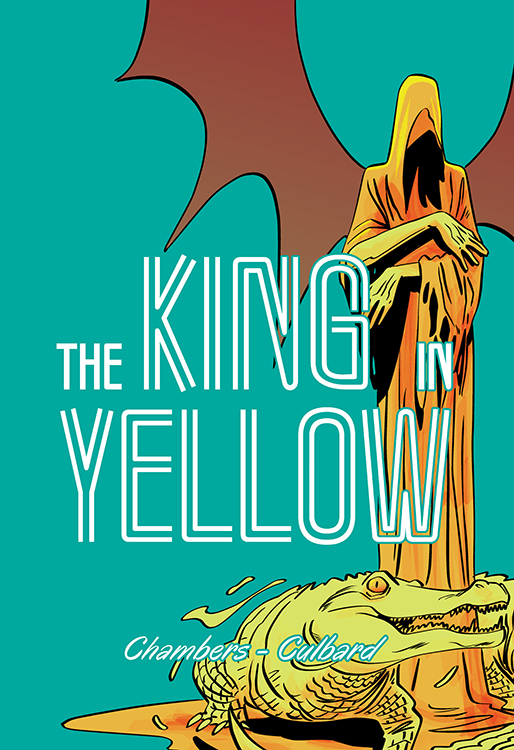Comic Book Review: The King in Yellow original stories by Robert W. Chambers, adaptation and art by I.N.J. Culbard
The King in Yellow was a book containing linked short stories by Robert W. Chambers. Within these stories, “The King in Yellow” is a play bound in book format, the full details of which are never disclosed. It’s said to be brilliantly written, but deeply disturbing; just reading it is enough to send fragile minds over the brink, and actually producing the play is…not recommended. And yet the book keeps popping up on people’s bookshelves, even if they are sure they never purchased it.

The anthology strongly influenced H.P. Lovecraft, especially the idea of books that could influence their readers to madness, and the King in Yellow was absorbed into the Cthulhu Mythos. (Hilariously, this edition makes the error of crediting Lovecraft as the original author on the indicia page, but nowhere else.) This adaptation illustrates four of the stories.
“The Repairer of Reputations” begins in the near-future year of 1920, and things are looking up. The Winthrop administration led America to victory over Germany in the Samoan War, Chicago has been fully rebuilt after the second Great Fire, efficient, clean subways have replaced noisy, ugly elevated trains, and suicide has been made legal, with Lethal Chambers in every town and city. (Wait, what?) But not everyone is happy.
Hildred Castaigne has discovered that he is, in fact, the rightful ruler of the Americas, with only his cousin Louis as a possible contender. His secret campaign to take over is supported by the title character, a Mr. Wilde. Mr. Wilde’s day job is fixing people’s reputations so that they can then return to polite society; he accomplishes this by having a network of agents he has blackmail material on, who then get him more blackmail material on more people who then fall under his power. With leverage on the right people, he can get the media and rumor mills to exonerate or destroy anyone he pleases.
However, a certain amount of what Hildred Castaigne tells us may not be strictly fact. It seems that he suffered a head injury some years back and was confined for a while, and also he’s read “The King in Yellow” and thinks it has coded messages just for him. His imperial crown, kept in a safe, might be a crude art project kept in a cardboard box.
Also, the entire takeover plot hinges on Mr. Wilde’s network, and when his abused cat decides it’s had quite enough….
“The Mask” takes place in Paris. A painter named Boris has developed a fluid that transforms any living object dunked in it into marble. His friend Alec is simultaneously fascinated and terrified by this. Alec’s also got a love triangle thing going on with Boris’ wife Genevieve. To the reader’s utter lack of surprise, there’s a horrific OSHA violation, but maybe it’s not a complete tragedy?
“The Yellow Sign” takes us back to New York, where painter Mr. Scott and his model/love interest have nightmares about the night watchman at the church next door. In the dreams, he drives a hearse, and one of them is inside the coffin. The night watchman might not be, strictly speaking, human based on testimony from a man who assaulted the creepy fellow.
“In the Court of the Dragon” is presented here as possibly a nightmare; Mr. Scott finds himself living in Paris, where he attends a church service. Only he notices that the organist is not a normal human being and that the music has unsettling undertones. When he leaves the church, the protagonist finds himself repeatedly coming across the organist, and in a perhaps hallucinatory finale, meets the King in Yellow itself.
The art is well-suited to the weird, somewhat dated material. I want to especially commend the coloring, as especially shades of yellow are an important theme in the stories.
Where this adaptation falls down a bit is that some of the exposition has been omitted, making what’s going on even harder to figure out than in the original.
Content note: suicide, animal abuse, female nudity. The treatment of insanity is period, and may be uncomfortable for modern readers.
I do recommend this to fans of weird fiction, particularly in the Lovecraftian vein, but for best effect you should also read the original book.

